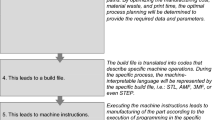Abstract
Interest from industry in reverse manufacturing is increasing due to market drivers such as higher costs for resources and increasing government legislation aimed at reducing waste. In order for companies to take advantage of this business opportunity, awareness and understanding of the role of uncertainty within reverse manufacturing and its influence on performance parameters of cost, time and quality must be acknowledged. Although decision support tools exist in literature, they currently lack a holistic approach in modeling the interrelated effects of performance parameters and uncertainty within the business. The purpose of this paper therefore is to propose a framework in which future decision tools can be created for reverse manufacturing. The effects of this framework are then demonstrated with current business scenarios, using reverse manufacturing case study examples.
Access this chapter
Tax calculation will be finalised at checkout
Purchases are for personal use only
Preview
Unable to display preview. Download preview PDF.
Similar content being viewed by others
References
Atkinson R (1999) Project management: cost, time and quality, two best guesses and a phenomenon, its time to accept other success criteria, Int. J. Project Manage. 17, 337-342.
Ferrer G, Whybark DC. (2001) Material Planning for a Remanufacturing Facility, Production and Operations Management 10, 112-124.
Geyer R, Van Wassenhove L N, Atasu A (2007) The Economics of Remanufacturing Under Limited Component Durability and Finite Product Life Cycles, Management Science 53, 88-100.
Guide V D R (2000) Production planning and control for remanufacturing: industry practice and research needs, J. Oper. Manage. 18, 467-483.
Guide V D R, Van Wassenhove L N (2009) The Evolution of Closed-Loop Supply Chain Research, Oper. Res. 57, 10-18.
Ijomah W L (2009) Addressing decision making for remanufacturing operations and design-for-remanufacture, - International Journal of Sustainable Engineering. 2, 91-102.
Ijomah W L, Hammond G P, Childe S J, McMahon C A (2005) A Robust Description and Tool for Remanufacturing: A Resource and Energy Recovery Strategy, Environmentally Conscious Design and Inverse Manufacturing, 2005. Eco Design 2005. Fourth International Symposium on, 472-479.
Ilgin M A, Gupta S M (2010) Environmentally conscious manufacturing and product recovery (ECMPRO): A review of the state of the art, J. Environ. Manage. 91, 563-591.
Jun H, Cusin M, Kiritsis D, Xirouchakis P (2007) A multi-objective evolutionary algorithm for EOL product recovery optimization: turbocharger case study, Int J Prod Res 45, 4573-4594.
Khang D B, Myint Y M (1999). Time, cost and quality trade-off in project management: a case study, Int. J. Project Manage. 17, 249-256.
Seitz M A (2007) A critical assessment of motives for product recovery: the case of engine remanufacturing, J. Clean. Prod. 15, 1147-1157.
Spengler T, Stolting W (2008) Life cycle costing for strategic evaluation of remanufacturing systems, Progress in Industrial Ecology, an International Journal 5, 65-81.
Subramanian R, Talbot B, Gupta S (2010) An Approach to Integrating Environmental Considerations within Managerial Decision-Making, Journal of Industrial Ecology 14, 378-398.
Umeda Y, Nonomura A, Tomiyama T, (2000) Study on life-cycle design for the post mass production paradigm, Artificial Intelligence for Engineering Design, Analysis and Manufacturing 14, 149-161.
Walsh B (2010) PSS for Product Life Extension through Remanufacturing, CIRP IPS2 Conference, Linköping, 261-268.
White C D, Masanet E, Rosen C M, Beckman S L (2003) Product recovery with some byte: an overview of management challenges and environmental consequences in reverse manufacturing for the computer industry, J. Clean. Prod. 11, 445-458.
Xanthopoulos A, Iakovou E (2009) On the optimal design of the disassembly and recovery processes, Waste Manage. 29, 1702-1711.
Zuidwijk R, Krikke H (2008) Strategic response to EEE returns:: Product eco-design or new recovery processes? Eur. J. Oper. Res. 191, 1206-1222.
Author information
Authors and Affiliations
Corresponding author
Editor information
Editors and Affiliations
Rights and permissions
Copyright information
© 2013 Springer-Verlag London
About this paper
Cite this paper
Goodall, P.A., Rosamond, E.L., Justham, L.M., Harding, J.A. (2013). Adapting the ‘Iron Triangle’ to Develop a Framework for Reverse Manufacturing Decision Support Tools. In: Stjepandić, J., Rock, G., Bil, C. (eds) Concurrent Engineering Approaches for Sustainable Product Development in a Multi-Disciplinary Environment. Springer, London. https://doi.org/10.1007/978-1-4471-4426-7_41
Download citation
DOI: https://doi.org/10.1007/978-1-4471-4426-7_41
Published:
Publisher Name: Springer, London
Print ISBN: 978-1-4471-4425-0
Online ISBN: 978-1-4471-4426-7
eBook Packages: EngineeringEngineering (R0)




